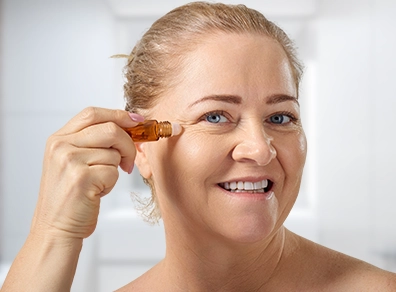
How to Oil Pull with Castor Oil for Clearer-looking Skin

How to Oil Pull with Castor Oil for Clearer-looking Skin
Written by: Heather Tanti R.P.N (non-practicing)
Reviewed by: Melanie Swachammer B.A.
Est. reading time: 9 minutes
Traditionally, oil pulling involves swishing oil in your mouth to support oral wellness, but did you know it can also be a game-changer for your skin?
Let’s dive into what oil pulling is all about, especially when using Castor Oil, and discover how it might just become your new skincare secret. First up, what exactly is oil pulling for your face?
What is Oil Pulling for your face?
When most people think of oil pulling, they imagine swishing oil around in their mouth to support oral wellness. However, this ancient practice can be adapted for skincare, offering a fresh twist on its traditional use. The concept is surprisingly simple: oil pulling for your face involves using oil- such as Castor Oil- as a cleansing agent to help remove impurities from your skin.
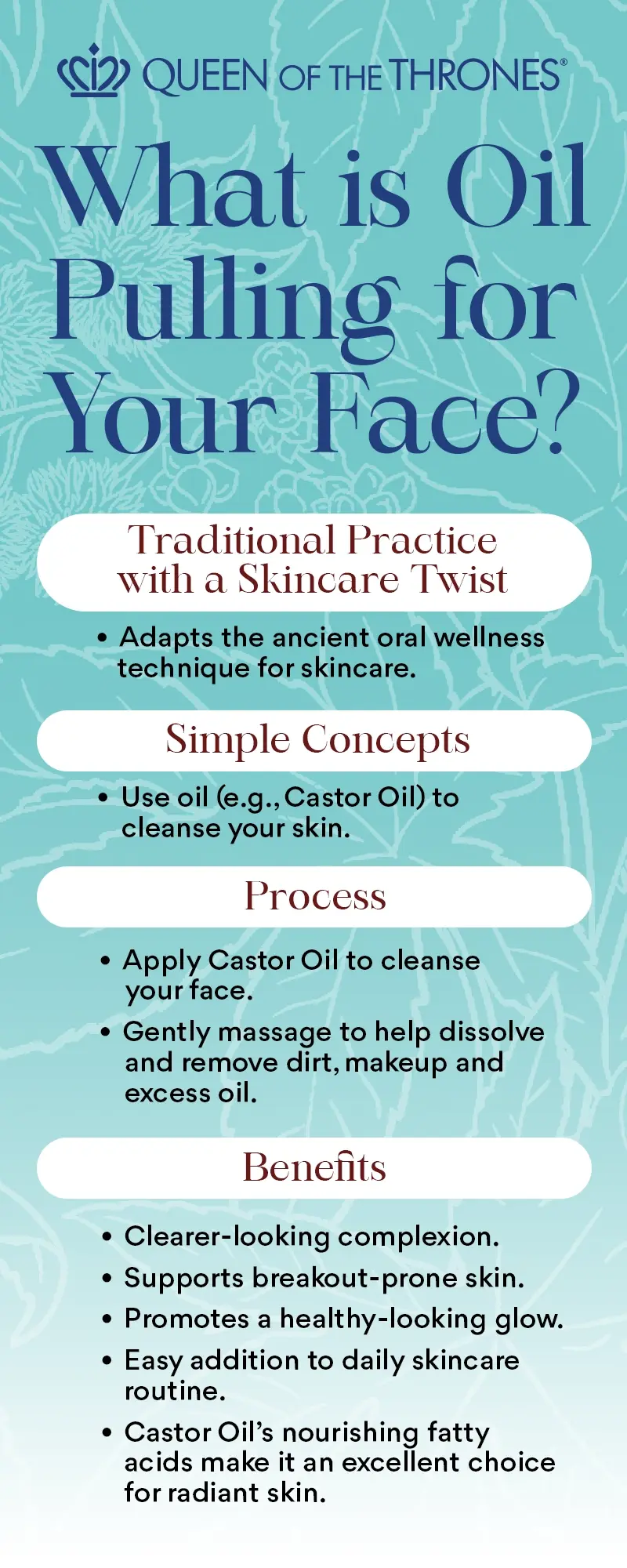
In essence, both oil pulling for oral care and oil pulling for the face have the same process. By applying oil to your face and gently massaging it, you help to dissolve dirt, excess oil, and other pollutants that accumulate on your skin throughout the day. This can lead to a clearer-looking complexion, support breakout-prone skin, and give you that healthy-looking glow.
So, how do you get started? It’s as easy as adding a few minutes to your daily routine. With Castor Oil’s unique properties, and nourishing fatty acids- it makes a fantastic choice for those looking for clean beauty options that support glowing, radiant skin.
Wondering what the main benefits of oil pulling for the face are? More on that next!
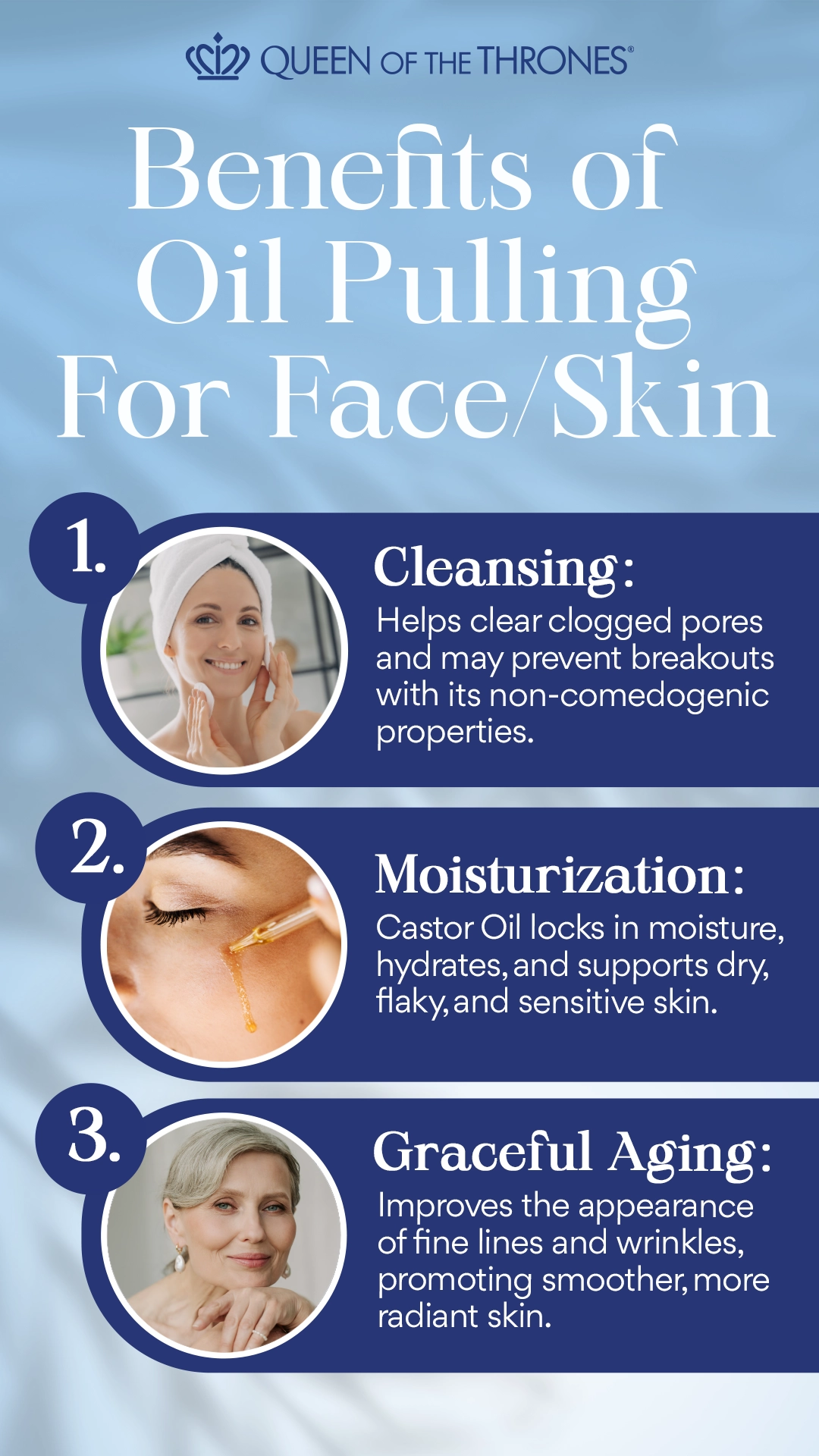
1. Moisturization
Castor Oil, in particular, is rich in fatty acids known for their excellent moisturizing properties. When massaged into the skin, Castor Oil not only hydrates but also helps support softer, smoother-looking skin.2a
Incorporating oil pulling into your skincare routine can leave your skin feeling soft and refreshed, making it a great option for those looking to enhance their skin’s hydration and overall appearance.
2. Cleansing of skin & clogged pores
Have you ever found yourself staring at your skin in the mirror, wondering why those stubborn pores just won’t clear up? You’re not alone. We’ve all been there, battling the blemishes and clogged pores that seem to have a mind of their own. If you’re on the hunt for something natural to give your skin the fresh start it craves, oil pulling with Castor Oil could be worth considering.
Castor Oil is well celebrated for its traditional and cosmetic benefits, and has been gaining traction as a powerful tool for skincare. While oil pulling is traditionally used for oral care, its benefits can extend to your skin, too.
The best part? Castor Oil is non-comedogenic. I know, I know… “non-comedo-what??”
Non-comedogenic simply means a product contains ingredients that won’t clog or block the pores on your skin.3 A non-comedogenic skincare product is a game-changer for those prone to breakouts. By being formulated to not block or clog pores, these products help prevent the buildup of impurities in your skin that often lead to breakouts. Sounds like a dream, agreed?
What does all this mean? Well, you can enjoy the benefits of Castor Oil without the added worry for your skin!
3. Improved appearance of fine lines & wrinkles
Castor Oil’s rich fatty acids work to nourish and hydrate your skin, while supporting smoother-looking skin.2b and also helps reduce the appearance of fine lines and wrinkles. As a result, you might notice your skin looking more vibrant and glowing.
Amazing, agreed? But how do you do it exactly? Keep reading!
How to oil pull your face
So, maybe you’ve tried the traditional way of oil pulling in the past by swishing an oil, like Castor Oil, around in your mouth for a designated length of time, is this you? Well, oil pulling for the face isn’t much different! Let’s explore some of the steps together.
A step-by-step guide
1. Cleanse Your Face:
Begin by thoroughly cleansing your face to remove any makeup, dirt, and impurities. Use a gentle cleanser suitable for your skin type.
2. Prepare the Oil Mixture:
In the small mixing bowl, combine the tablespoon of organic Castor Oil with the optional 2 drops of tea tree essential oil.
Mix well until all ingredients are fully combined.
3. Apply the Oil: Take a small amount of the oil mixture and apply it to your face. Ensure even coverage, focusing on areas prone to blackheads, clogged pores, or dryness.
4. Massage: Gently massage the oil into your skin using circular motions for about 5-10 minutes. This helps to dissolve impurities, excess oils, and unclog pores.
…Want to dive deeper? Click below to download the free full step-by-step guide with your DIY Oil Pulling for Clearer, Glowing Skin with Castor Oil!
Most Common and Best Oils for Oil Pulling Face/Skin
Now that we’ve gone through the basics of what oil pulling for the face is, and how it can elevate your skincare routine, let’s dive into some of the most common oil choices for this ancient practice.
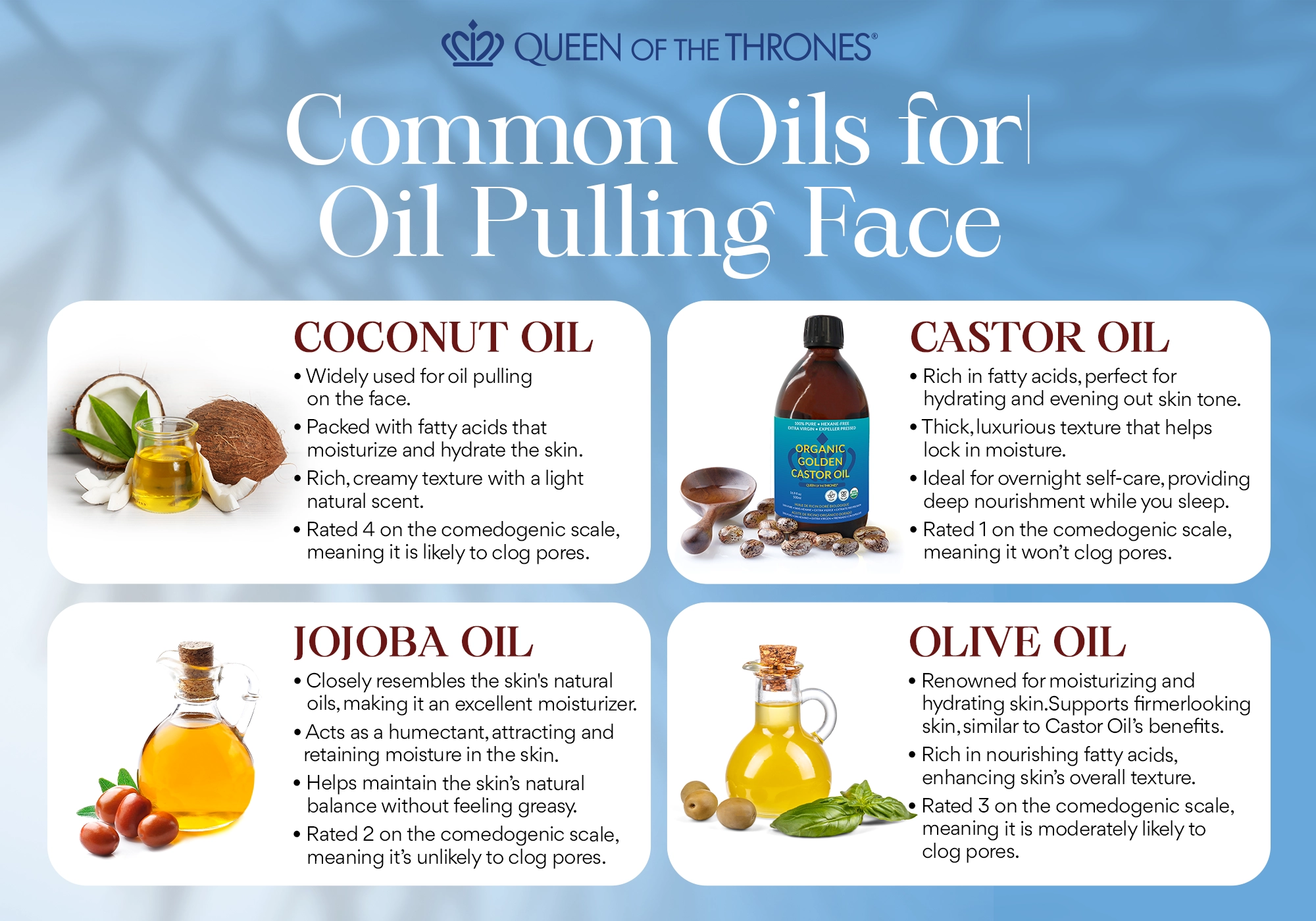
Coconut Oil
When it comes to oil pulling for your face, coconut oil is often the most widely used. This tropical treasure is packed with fatty acids, that are known to help moisturize and hydrate the skin.4
Its rich, creamy texture and light natural scent feel like you’re bringing the serenity of the ocean waves straight to your skin.
However, coconut oil is rated a 4 on the comedogenic scale, meaning it is highly likely to clog pores, so it may not be best for this practice (especially on breakout-prone skin on the face).
Castor Oil
It’s thick and luxurious, like a comforting blanket that helps lock in moisture.5 Castor Oil is especially great for overnight self-care, working its feel-good magic while you sleep!
And as mentioned earlier, it’s rated a 1 on the comedogenic scale, meaning it has the lowest likelihood of clogging your pores.
So, if you’re looking for a deeply nourishing option, Castor Oil might just be your fave!
Jojoba Oil
When used for oil pulling, jojoba oil may help your skin’s natural balance, helping it to feel hydrated without feeling greasy. Jojoba oil is rated a 2 on the comedogenic scale, so like Castor Oil, it’s known to be gentle on the skin, which is great for those with sensitive skin.
Olive Oil
However, olive oil sits a bit higher on the comedogenicity scale at a 3, meaning it’s more likely to clog your pores than Castor or jojoba oil, but not as high as coconut.
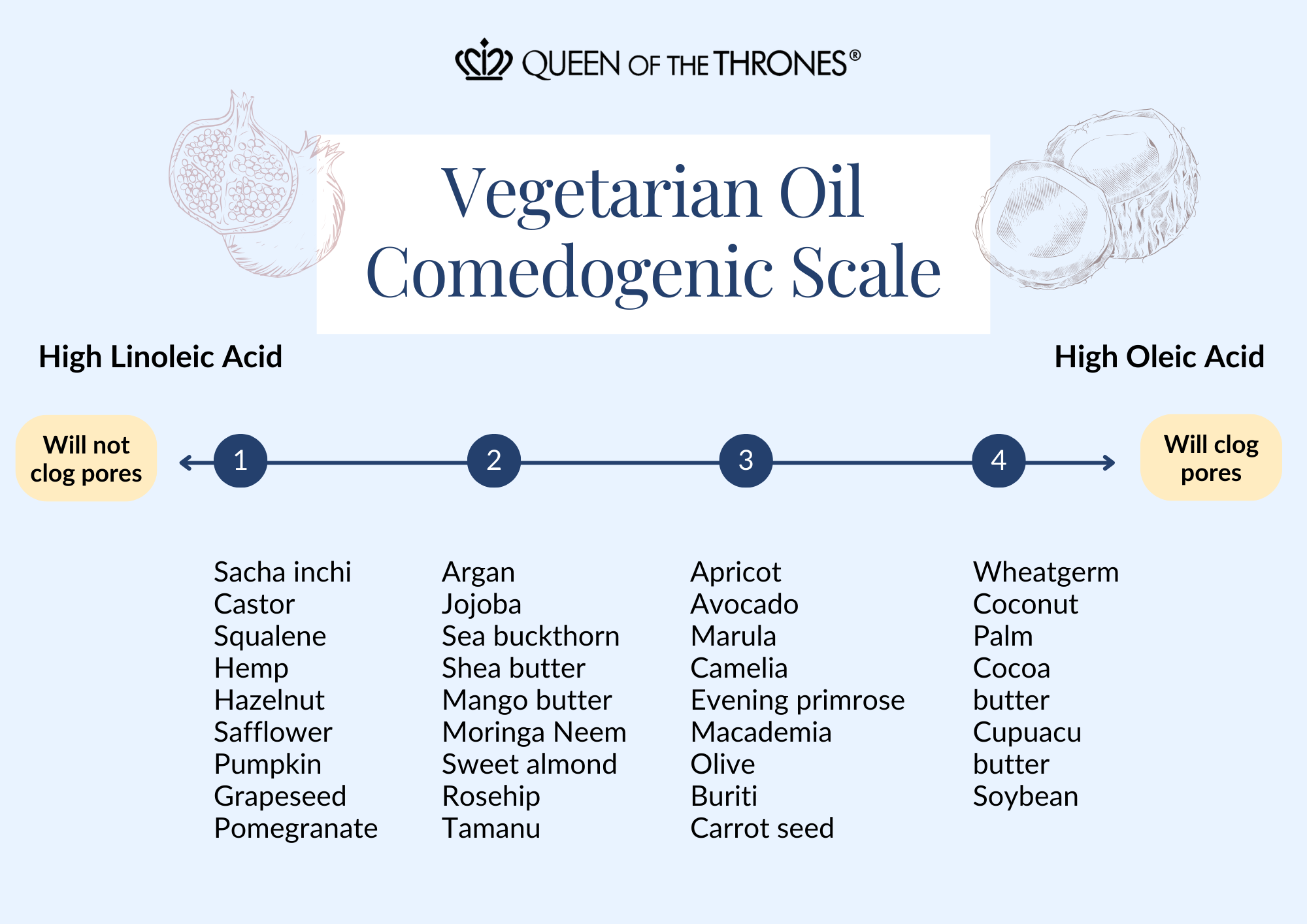
So, whether you choose coconut oil, Castor Oil, jojoba oil, olive oil, or something else altogether, natural skincare routines are available to support your beauty needs.
But what if you have specific skin concerns, is it still okay to oil pull?
Oil Pulling for clogged pores & sebaceous filaments
Are you looking to try oil pulling for your face for specific skin issues? The internet is full of beauty influencers raving about the gentle practice of face oil pulling for clogged pores and sebaceous filaments.
Sebaceous what? Let’s dive further!
Oil pulling for sebaceous filaments
The good news is that with the right routine, like oil pulling for the face, you can lessen their appearance by supporting your skin’s natural oils, which can help your face look clearer and smoother.9b
Oil pulling for clogged pores
Oil pulling for the face can support the appearance of clearer pores and enhanced skin clarity. By massaging oils like castor or jojoba onto your skin, you may help dissolve impurities and excess sebum that can block pores. This gentle cleansing process may not only aid in unclogging pores but also provides nourishing hydration, leaving your skin feeling soft and refreshed.
Regular oil pulling may contribute to a clearer-looking complexion, promotes an even skin tone, and a radiant, healthy-looking glow. It’s a natural, easy-to-implement addition to any skincare routine, particularly for those looking to manage breakouts and dullness.
FAQs & Common Concerns
Now that we’ve weaved through the different elements of oil pulling for a natural skincare routine, let’s address 3 common questions that may be on your mind!
Oil pulling for clogged pores
Oil pulling for your face can be a great addition to your skincare routine. Many people find it to be a natural and supportive way to cleanse and nourish their skin. The best oils are ones that are low on the comedogenic scale, such as e castor or jojoba to avoid clogging pores. This can support the appearance of clearer pores and smoother-looking skin.
One of the best things about oil pulling for your skin is how moisturizing it is. Unlike some harsh cleansers that can strip your skin of its natural oils, oil pulling helps leave your skin feeling hydrated and supple.
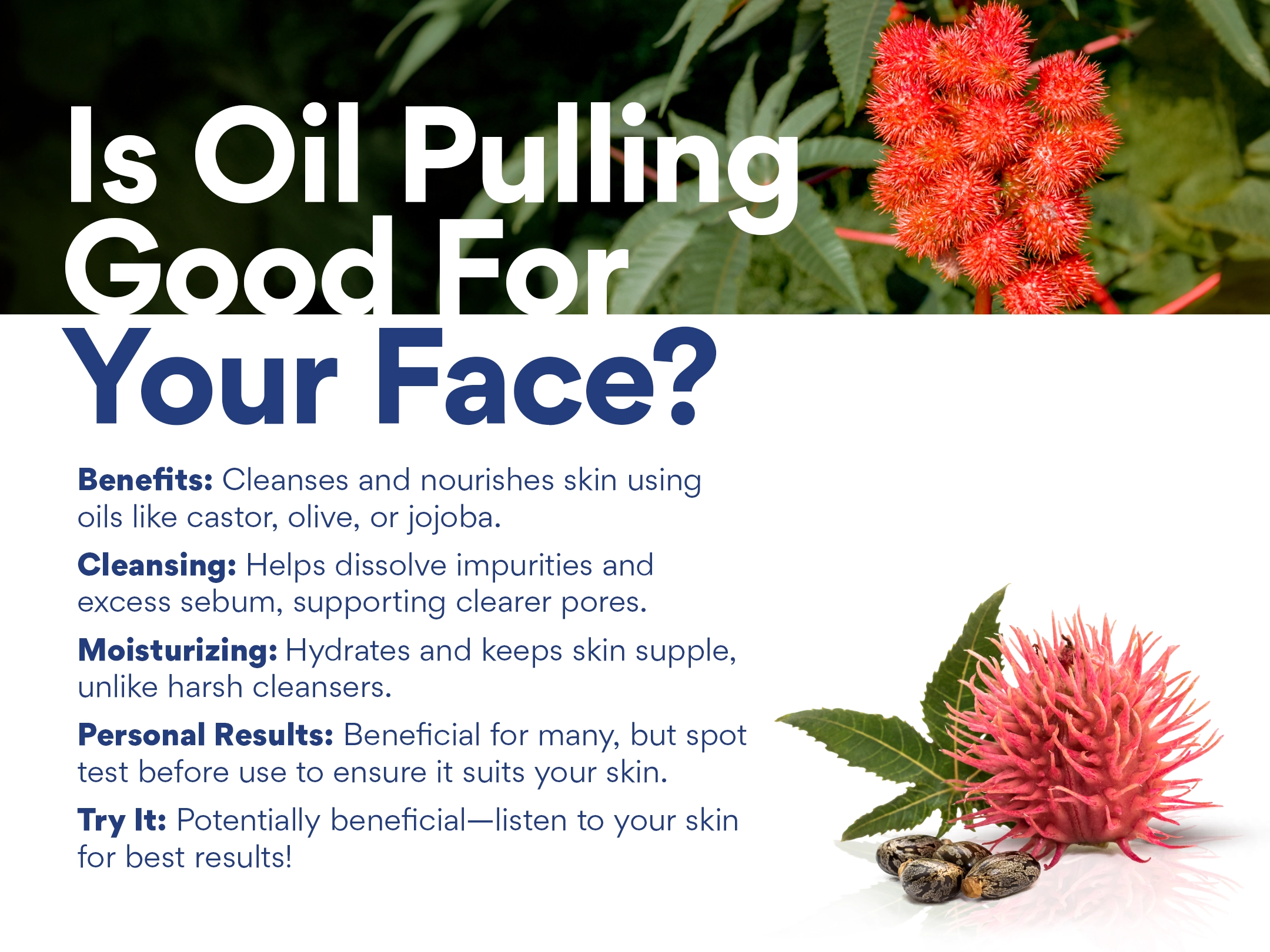
Now, you might be wondering if it works for everyone. While many people see positive results, skincare is very personal, agreed? What works wonders for one person might not be as beneficial for another. So, it’s always a good idea to spot test any new skincare method or product to see how your skin reacts.
So, is oil pulling good for your skin? It definitely has the potential to be! Give it a try and see how your skin responds. And as always, listen to your skin—it’s the best guide to help you know exactly what it needs.
How often should you oil pull?
When it comes to how often you should oil pull, it really depends on your skin type and what you’re comfortable with. For most people, starting once or twice a week is a good idea. This gives your skin time to adjust to the new routine without overwhelming it.
If you have oily or breakout-prone skin, you might find that oil pulling once a week is plenty to keep your skin moisturized and clear-looking.
On the other hand, if you have dry or sensitive skin, you might benefit from oil pulling daily or a few times a week. The key is to observe how your skin responds and adjust accordingly.
Consistency is important, but there’s no need to overdo it. And of course, always listen to your skin. If it feels irritated or too oily, it might be a sign to cut back a bit.
Are there precautions I should take before oil pulling?
Yes, definitely! While oil pulling for your face can be a wonderful addition to your skincare routine, there are a few precautions to keep in mind.
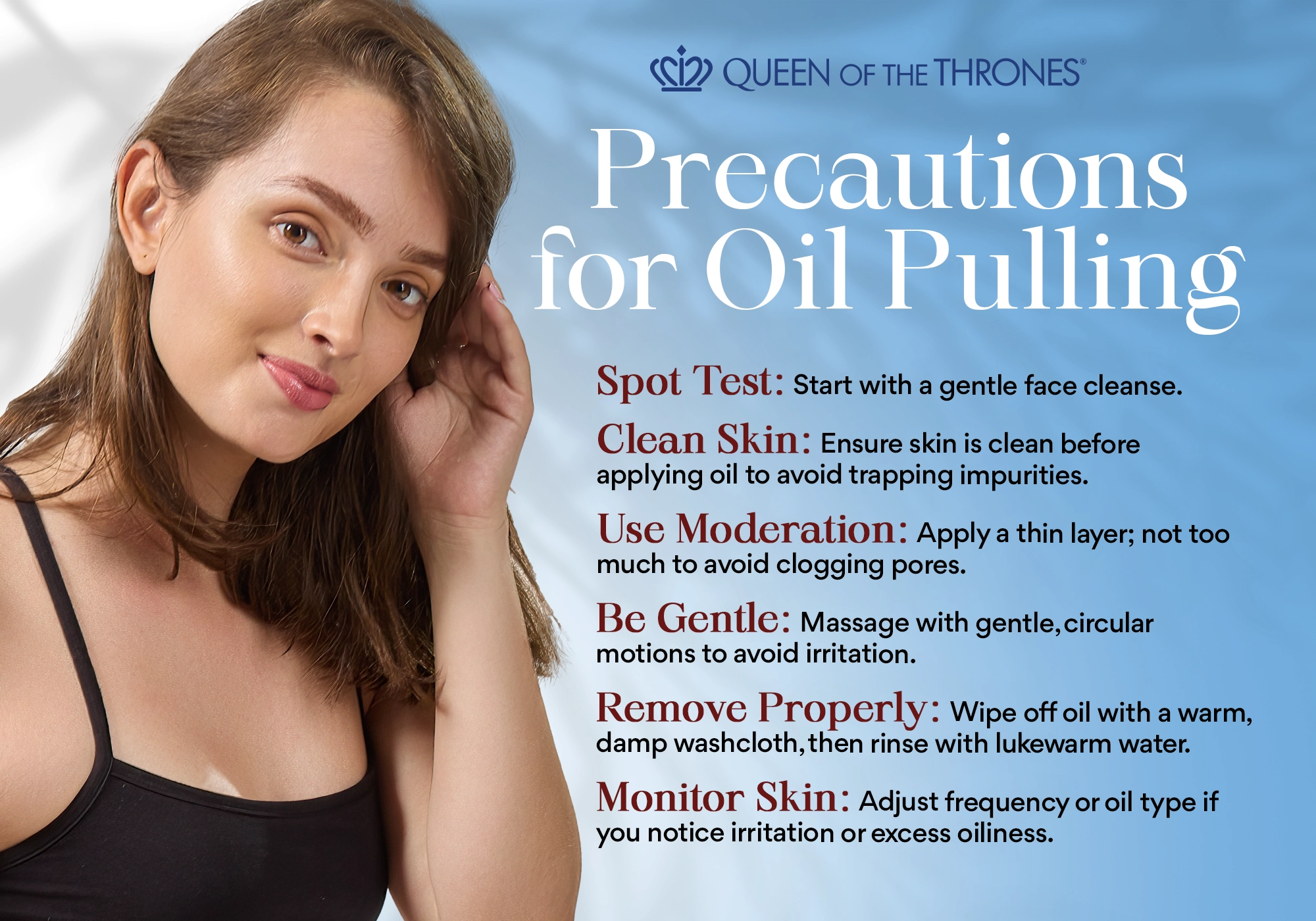
1. Firstly, always start with a spot test. Apply a small amount of the oil you’re planning to use (like castor, coconut, olive, or jojoba) to a small area of your skin, such as the inside of your wrist or behind your ear. Wait 48 hours to see if you have any adverse reactions, like redness, itching, or irritation. In rare cases a reaction may occur, in which case discontinue use. This step is important, especially if you have sensitive skin or are prone to allergies.
2. Make sure your skin is clean before you start oil pulling. This helps to remove surface dirt and makeup, allowing the oil to absorb better. You don’t want to trap any impurities in your skin by massaging them deeper with the oil.
3. Use the right amount of oil. You don’t need a lot—just enough to cover your face lightly. Using too much oil can be overwhelming for your skin and might lead to clogged pores, especially if you have oily or breakout-prone skin. Tip to keep in mind: Less is more!
4. Be gentle when massaging the oil into your skin. There’s no need to scrub or apply too much pressure. Gentle, circular motions will help the oil to do its job without irritating your skin.
5. After oil pulling, it’s important to remove the oil properly. Use a warm, damp washcloth to gently wipe away the oil, and then follow up with a rinse using lukewarm water. This helps to ensure that any impurities lifted by the oil are fully removed from your skin.
6. Lastly, listen to your skin. If you notice any signs of irritation or if your skin feels excessively oily after oil pulling, it might be a sign to reduce the frequency or try a different oil.
What about dairy?
So you see, incorporating oil pulling into your skincare routine can offer numerous benefits. Using non-comedogenic oils like Castor Oil, provides a gentle, yet supportive cleanse, helping to reduce the appearance of fine lines and wrinkles, while keeping skin hydrated, soft and glowing.
Its nourishing properties and ability to help cleanse pores, make it a valuable addition to your skincare regimen.
To get started on your journey to glowing, youthful-looking skin, click below to download your free, easy DIY oil-pulling recipe with Castor Oil!
Have you tried oil-pulling before? Share your experience below, and let us know which oil is your favorite go-to for this natural skincare practice!
Are you a practitioner, health coach or wellness influencer? If you’re interested in recommending our easy-to-use tools and practically applying them in your health and wellness professional practice, in clinic, or online with the people you serve, you can join now!
Click here for references
1. Singh A, Purohit B. Tooth brushing, oil pulling and tissue regeneration: A review of holistic approaches to oral health. J Ayurveda Integr Med. 2011 Apr;2(2):64-8. doi: 10.4103/0975-9476.82525. PMID: 21760690; PMCID: PMC3131773.
2a. Goyal A, Sharma A, Kaur J, Kumari S, Garg M, Sindhu RK, Rahman MH, Akhtar MF, Tagde P, Najda A, Banach-Albińska B, Masternak K, Alanazi IS, Mohamed HRH, El-Kott AF, Shah M, Germoush MO, Al-Malky HS, Abukhuwayjah SH, Altyar AE, Bungau SG, Abdel-Daim MM. Bioactive-Based Cosmeceuticals: An Update on Emerging Trends. Molecules. 2022 Jan 27;27(3):828. doi: 10.3390/molecules27030828. PMID: 35164093; PMCID: PMC8837976.
2b. Goyal A, Sharma A, Kaur J, Kumari S, Garg M, Sindhu RK, Rahman MH, Akhtar MF, Tagde P, Najda A, Banach-Albińska B, Masternak K, Alanazi IS, Mohamed HRH, El-Kott AF, Shah M, Germoush MO, Al-Malky HS, Abukhuwayjah SH, Altyar AE, Bungau SG, Abdel-Daim MM. Bioactive-Based Cosmeceuticals: An Update on Emerging Trends. Molecules. 2022 Jan 27;27(3):828. doi: 10.3390/molecules27030828. PMID: 35164093; PMCID: PMC8837976.
- Sethi A, Kaur T, Malhotra SK, Gambhir ML. Moisturizers: The Slippery Road. Indian J Dermatol. 2016 May-Jun;61(3):279-87. doi: 10.4103/0019-5154.182427. PMID: 27293248; PMCID: PMC4885180.
- Pham TL, Thi TT, Nguyen HT, Lao TD, Binh NT, Nguyen QD. Anti-Aging Effects of a Serum Based on Coconut Oil Combined with Deer Antler Stem Cell Extract on a Mouse Model of Skin Aging. Cells. 2022 Feb 9;11(4):597. doi: 10.3390/cells11040597. PMID: 35203249; PMCID: PMC8870445.
- Harwood A, Nassereddin A, Krishnamurthy K. Moisturizers. [Updated 2024 Feb 12]. In: StatPearls [Internet]. Treasure Island (FL): StatPearls Publishing; 2024 Jan-. Available from: https://www.ncbi.nlm.nih.gov/books/NBK545171/
- Gad HA, Roberts A, Hamzi SH, Gad HA, Touiss I, Altyar AE, Kensara OA, Ashour ML. Jojoba Oil: An Updated Comprehensive Review on Chemistry, Pharmaceutical Uses, and Toxicity. Polymers (Basel). 2021 May 24;13(11):1711. doi: 10.3390/polym13111711. PMID: 34073772; PMCID: PMC8197201.
- Meyer J, Marshall B, Gacula M Jr, Rheins L. Evaluation of additive effects of hydrolyzed jojoba (Simmondsia chinensis) esters and glycerol: a preliminary study. J Cosmet Dermatol. 2008 Dec;7(4):268-74. doi: 10.1111/j.1473-2165.2008.00405.x. PMID: 19146603.
- Alnemer F, Aljohani R, Alajlan A, Aljohani M, Alozaib I, Masuadi E, Omair A, Al Jasser MI. The use of olive oil for skin health in a Saudi population: A cross-sectional study. Dermatol Reports. 2021 Dec 17;14(1):9364. doi: 10.4081/dr.2022.9364. PMID: 35399371; PMCID: PMC8991441.
9a. Mineroff JP, Hyde JT, Hsu S. A Case Report of Sebaceous Filaments. Cureus. 2023 Nov 11;15(11):e48656. doi: 10.7759/cureus.48656. PMID: 38090399; PMCID: PMC10712575.
9b. Mineroff JP, Hyde JT, Hsu S. A Case Report of Sebaceous Filaments. Cureus. 2023 Nov 11;15(11):e48656. doi: 10.7759/cureus.48656. PMID: 38090399; PMCID: PMC10712575.

